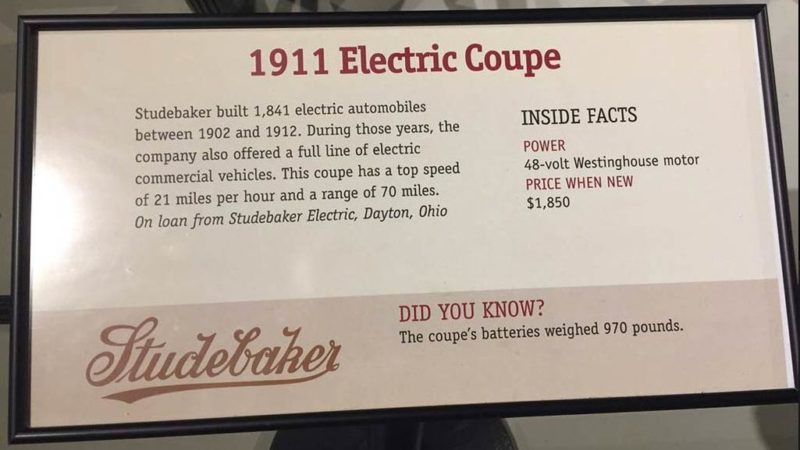When Tesla CEO Elon Musk visited the Studebaker museum in South Bend, Indiana, he unleashed what has morphed into a social media-style history lesson on electric vehicles.
It’s too good for words, but we’ll do our best to insert some useful ones here and there, among the many responses that fans posted to Musk’s original Twitter post, after loading up some photos he took of the 1911 Studebaker electric coupe on show at the industrial history museum.
First up, interesting facts about Studebaker’s foray into early 20th century EVs: 1,841 built in total, with the one pictured able to go 70 miles (over 110km) with a 48v motor, 970 pound (31kg) battery at a top speed of 21mph (33km/hr).
At $US1,850 in 1911, it would have cost around $US50,000 in today’s money!
As J. M. Studebaker himself put it, “(Gasoline-powered vehicles) are clumsy, dangerous, noisy brutes which stink to high heaven, break down at the worst possible moment, and are a public nuisance.”
Studebaker Museum in South Bend pic.twitter.com/Odti9y0McC
— Elon Musk (@elonmusk) October 10, 2018
Next up: a 1910 electric Victoria Phaeton built by Bailey Electric, with left hand drive, most likely carrying an Edison battery.
Adverts of the time claimed 100 miles (160km) range, and a respectable person (or otherwise for that matter) could get their hands on one for $US2,400-2,600 ($US63,000-69,000/$A89,000-97,500 approx in today’s prices).
Now we can make them fly.. if the driptubes in DC would get out of the way. pic.twitter.com/ZntFk8kKYi
— Scott soulia (@scott_soulia) October 10, 2018
Another interesting fact: Porsche’s first ever car was an electric car! Maker of the concept EV Mission E (soon to be Taycan), first made the Modell C.2 Phaeton in 1898.
It weighed 1350kg, had a range of about 80km and a top speed of 35km/hr. Only four were ever made.
Very first Porsche vehicle was electric from 1898. Modell C2 Phaeton pic.twitter.com/JxXmoVqEb3
— scott jiles (@jilesnet) October 10, 2018
A descendant of the Studebaker family, Maxwell Hardy chipped in, sharing the full-circle fact that he is now a proud owner of a Tesla Model S.
Hey @elonmusk I am a direct descendant of the Studebaker family, and now a proud S owner. What a full, electric circle! pic.twitter.com/dADN2WC6pi
— Max (@maxwellhardy) October 10, 2018
Another fan shared an old Detroit newspaper page showing an advert for a Detroit ‘electric carriage’.
These early electric cars built in the US automotive industry stronghold could drive up to 241 miles (386km) according to a site dedicated to the pioneering automaker.
My family has a framed copy of this newspaper from 1910 with a big ad for the Detroit Electric “carriage” pic.twitter.com/n17dBa6qLq
— Max Urquhart (@max_urquhart) October 10, 2018
At the Henry Ford museum in Dearborn, Michigan, is an electric tri-wheeled vehicle built in 1896 by inventor Andrew Riker as a teenager.
Riker went on to found the Riker Electric Motor Company but was hired later on by Locomobile to develop ICEs.
Henry Ford Museum, Dearborn, MI
Electric car pic.twitter.com/ZPdBnz1ktr— Chris (@CC_823) October 10, 2018
A fan from over the Atlantic shared a photo from the Automobile Museum of Málaga, Spain of a Model 22 Brougham, made by Milburn Electric in 1916.
Museo automovilístico Málaga pic.twitter.com/QhTTSh7ZWj
— Antonio Gómez León (@AntonioGomezL) October 10, 2018
It goes on! Another fan shared a short video of a 1911 Baker Electric—and says that Jay Leno also has one.
Baker made EVs as early as 1902, and there is one report that even Edison himself bought one.
Our company built the Baker Electric in 1911. @jayleno has one too pic.twitter.com/Rb99RJohGq
— Vincent Halma (@vincenthalma) October 10, 2018
Another Detroit Electric. As fan Maxwell P Jackson says, “Then, sometime before World War II, the electric car quietly disappeared from the automotive scene…”
Here’s a 1916 Detroit Electric Brougham Model 60 @forney_museum in Denver.
“Then, sometime before World War II, the electric car quietly disappeared from the automotive scene…” pic.twitter.com/JC32BUx3xx
— Max Jackson (@MaxwellPJackson) October 10, 2018
Two EVs from 1912, a Ford and a Studebaker.
Ford are now returning to the EV fold with their Ford Focus EV, among other electrified options.
Not far from your post is one of my favorite auto museums in #Volo, IL where *almost* everything is for sale.
The inventory is a true spread (6+ buildings) & a visit will expose far more than pics.
This is a 1912 #Ford & a 1912 #Studebaker both #EV.https://t.co/BL9sJXTMPK pic.twitter.com/oFUKDH9BCH
— Schecky Tech (@ScheckyTech) October 10, 2018
And last, but not least: Beating Chinese Nio’s EP9 for world’s fastest EV by almost 120 years is La Jamais Contente (“The Never Satisfied”), a rocket type electric vehicle built in 1899 which not only was the world’s fastest car at the time, but the first ever to travel at speeds of over 100km/hr.
In 1899 the electric car “La jamais contente” became the fastest car in the world and the first to reach 100km/h pic.twitter.com/1JRBitI4RN
— Armand (@JoachBandit) October 10, 2018
Electric cars remained a popular choice for many due to their relatively easy starting, but with the introduction of an electric starter to ICE cars which made them much easier to start than the previous method cranking the engine, coupled with the mass-production of ICE engines by Ford Motors dramatically dropping the cost of early ICE cars well below that of EVs, the early age of electric cars succumbed, by around 1922, to the ‘heyday’ of fossil fuel.
Thanks Elon for getting that conversation started!

Bridie Schmidt is associate editor for The Driven, sister site of Renew Economy. She has been writing about electric vehicles since 2018, and has a keen interest in the role that zero-emissions transport has to play in sustainability. She has participated in podcasts such as Download This Show with Marc Fennell and Shirtloads of Science with Karl Kruszelnicki and is co-organiser of the Northern Rivers Electric Vehicle Forum. Bridie also owns a Tesla Model Y and has it available for hire on evee.com.au.

